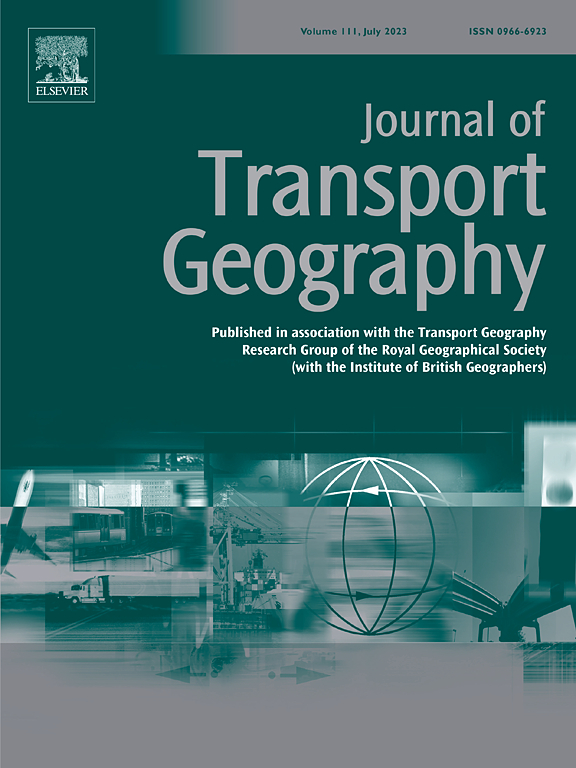用于公共交通需求准确预测的神经模糊深度学习框架:利用空间和时间因素
IF 6.3
2区 工程技术
Q1 ECONOMICS
引用次数: 0
摘要
高效的公共交通需要创新的规划和运营策略。准确的需求预测是至关重要的,因为它受到各种空间和时间因素复杂的非线性相互作用的影响。本研究提出了神经模糊推理和深度学习模型来预测马什哈德交通区域的公共交通需求,以增强运营规划。该模型的灵活性允许整合不同的时间和空间变量。对基于两个数据集开发的四种自适应神经模糊推理系统(ANFIS)和长短期记忆(LSTM)模型进行了评估和比较。数据集一和数据集二包含了所有可能的变量,但没有预先判断它们的影响,分别包括每日和每年的范围。数据集3和4使用随机森林算法从以前的数据集中识别出的影响变量,从而更快地处理并减少误差。采用MSE(均方误差)、BIAS、R2(决定系数)、WI (Willmott指数)和NSE (Nash-Sutcliffe效率)5个统计系数来评价模型的性能。结果表明,LSTM神经网络模型在短期日尺度(MSE = 0.0006, BIAS = 0.9308, R2 = 0.9047, WI = 0.7591, NSE = 0.9047)和ANFIS模型在长期年尺度(MSE = 0.0024, BIAS = 0.0229, R2 = 0.9415, WI = 0.9730, NSE = 0.8738)对马什哈德公交和轨道交通系统需求的预测效果较好。本研究的预测模型使规划者能够估计马什哈德不同城市利用水平下的公共交通需求,为不同交通区域的日常和年度视野提供见解。本文章由计算机程序翻译,如有差异,请以英文原文为准。
A neuro-fuzzy and deep learning framework for accurate public transport demand forecasting: Leveraging spatial and temporal factors
Efficient public transportation requires innovative planning and operational strategies. Accurate demand forecasting is crucial, as it is influenced by complex, non-linear interactions of various spatial and temporal factors. This study proposes a neuro-fuzzy inference and deep learning models to predict public transport demand in Mashhad's traffic zones for enhanced operational planning. The model's flexibility allows the integration of diverse temporal and spatial variables. Four Adaptive Neuro-Fuzzy Inference Systems (ANFIS) and Long Short-Term Memory (LSTM) models developed with two datasets were evaluated and compared to each other. Datasets one and two contained all possible variables without pre-judging their impact, encompassing daily and yearly horizons, respectively. Datasets three and four employed the identified influential variables from previous datasets using the Random Forest algorithm, leading to faster processing and reduced error. Five statistical coefficients including MSE (Mean Squared Error), BIAS, R2 (Coefficient of Determination), WI (Willmott Index) and NSE (Nash-Sutcliffe Efficiency were presented to evaluate the performance of the proposed models. The results showed that the LSTM neural network model in the short-term daily scale (MSE = 0.0006, BIAS = 0.9308, R2 = 0.9047, WI = 0.7591, NSE = 0.9047) and the ANFIS model in the long-term annual scale (MSE = 0.0024, BIAS = 0.0229, R2 = 0.9415, WI = 0.9730, NSE = 0.8738) achieved superior performance in predicting demand for bus and rail systems in Mashhad. This research's forecasting models enable planners to estimate public transport demand under varying utilization levels of urban uses in Mashhad, offering insights for both daily and annual horizons across different traffic zones.
求助全文
通过发布文献求助,成功后即可免费获取论文全文。
去求助
来源期刊

Journal of Transport Geography
Multiple-
CiteScore
11.50
自引率
11.50%
发文量
197
期刊介绍:
A major resurgence has occurred in transport geography in the wake of political and policy changes, huge transport infrastructure projects and responses to urban traffic congestion. The Journal of Transport Geography provides a central focus for developments in this rapidly expanding sub-discipline.
 求助内容:
求助内容: 应助结果提醒方式:
应助结果提醒方式:


